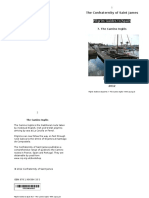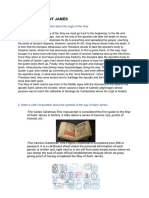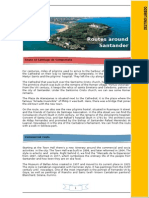The Way
The Way
Uploaded by
shehawehCopyright:
Available Formats
The Way
The Way
Uploaded by
shehawehOriginal Description:
Copyright
Available Formats
Share this document
Did you find this document useful?
Is this content inappropriate?
Copyright:
Available Formats
The Way
The Way
Uploaded by
shehawehCopyright:
Available Formats
The Way
an Emilio Estevez Film
HISTORY AND HERITAGE
For over a thousand years, the Camino de Santiago has led travelers to the shrine and relics of St. James the Apostle in Galicia, the northwest corner of Spain. The crypt of the Cathedral of Santiago de Compostela, titled for Jamess common Spanish name (Sanctus Jacobus, Sancti Yage, Santiago), has long been one of Christianitys premier pilgrimage sites. While Rome and the Holy Land surpassed it in popularity during the Middle Ages, Santiago outstripped them in forging myriad mythic trails such as the Camino francs (the French Route from the Pyrenees), the Ruta mozrabe (the Mozarabic Route that skims the north of Portugal) and the Va de la Plata (the Silver Route that starts in Seville). The cry of Ultreya or Go beyond rang out along a thousand highways of hope. During the height of its popularity from the twelfth through the fifteenth centuries, the trek to Santiago attracted perhaps as many as a hundred thousand pilgrims a year. Travelers sought a chance to pray in Pilgrimage fell from favor in the early modern period in the face of stiffening national identities and borders and new conceptions of faith. Protestant reformers pointedly denounced the abuses of casual pilgrimage and its often carnivalesque trappings. Even the once choked roads to Santiago lapsed into silence. Lonely travelers made their own shelter in increasingly abandoned structures where the footsteps of aged guardians echoed the presence of one of Christs closest friends and the first apostle to be martyred. They also came to beg for cures for illness or affliction, to ensure blessings for their families or communities, to repent their sins, and to overcome their doubts and stumbling faith. A rosary of sublime monuments, folksy secondary shrines, and hospitable monasteries and refuges were created to welcome vulnerable travelers. In return, these seekers gave their good will, artistry and labor to the Camino as they passed by.
along crumbling corridors. The Route of St. James became a trail smudged by time. But in the late twentieth century, for reasons that remain unclear, spiritual seekers and scholars began to thread their way along the nearly forgotten byways to Santiago once again. Spain undertook the mission of recovering the Camino as part of its national heritage, publicizing the ancient routes and investing in a simple infrastructure of well marked scenic trails. Town councils, parishes and local associations of Friends of the Camino equipped modest refuges (albergues or refugios) to provide a nights shelter at minimal cost. The goal was to provide safe passage for those hoping to breathe the same air, experience the same landscapes, and rest in the same cool churches that inspired an age of faith. The tide of modern pilgrims now approaches a quarter million per year who undertake at least portions of the various Caminos in Spain, starting from their homes within Iberia, or trekking from lsewhere in Europe.
Thousands more come from Brazil, Canada, Mexico, the United States, South Africa, Israel and Japan to reenact the rites of pilgrimage. Associations of Friends of the Camino in nearly every Spanish province, and in England, France, Norway and the United States produce magazines, newsletters, and websites. The success of the Spanish Camino phenomenon has excited the emulation, even the envy, of neighboring states. Hungary boasts its own circuit of shine sites, and Norway has a consecrated trail from Oslo to Trondheim in honor of St. Olaf. Italian authorities are attempting to reestablish travelers itineraries connecting Rome with Santiago. As internal tourism grows within the European Union and national borders have become porous, pilgrimage once more is performing its former function of blurring local loyalties and making them look petty.
THE WHY AND HOW OF MODERN PILGRIMAGE
Pilgrimage is travel for transformation. Those who believe in the transcendent universally believe in humankinds potential to approach the sacred on its own turf. Modern pilgrims are often uncertain about the depth of their faith. Though hesitant to declare themselves best examples of any one church or tradition, many do sense the potential of travel to spark change from within as well as to expose them to new cultures, creeds, and foods. In an age of jet travel, the rhythms of walking make pilgrimage a refreshing experience, body centered and soul centering. The Camino de Santiago or the Way of Saint James is a spiritual journey that pilgrims of diverse spiritualities and backgrounds have traversed for a thousand years. Pilgrimage essentially begins at ones doorstep, but once in Europe there are countless routes leading to Santiago from all directions, the most popular being the Camino francs which crosses the Pyrenees along the Spanish-French border. Along the way travelers encounter charitable or family operated shelters that cater specifically to the thousands of pilgrims of all ages who make the journey each year, immersing themselves in regional cuisines, architecture and landscapes. Some travelers choose a more reflective, slower pace, others walk briskly from much further away. Despite its solitary nature, the journey to Santiago de Compostela has always been one of rhythms. The soft churning of footfalls, the cadence of the wind, the alternation of eloquent open country with holy chanting by morning This Camino covers nearly 800 kilometers (some 500 miles) traversing an idyllic, rolling Spanish countryside. By following the yellow arrows painted along the trails, a pilgrim can expect to walk 15-25 km (10-15 miles) a day to reach his next nights shelter and welcome. At this pace, a pilgrim can reach the Cathedral de Santiago in 6 to 8 weeks to attend one of the several Pilgrims Masses held at the cathedral in Santiago each day.
and merry conversation by night become the yardsticks of time for the wandering pilgrim. Sometimes the very blankness of the countrysidein Spain one speaks of the central meseta as a terrain where the sky is your landscapeinvites the modern pilgrim as much as his or her medieval predecessors to look inward. Pilgrims still walk the Camino for a variety of reasons, some to fulfill promises, others seek enlightenment, and still others long for adventure. All, however, lean forward toward the western sky, the Cathedral in Santiago, and the remains of the apostle. Most pilgrims choose to carry a scallop shell with them as a symbol of their journey in honor of St. James, a medieval token of having sought the farthest coast of the known European continent. Another, perhaps more useful symbol is a walking stick to aid a weary pilgrim on his or her journey. Pilgrims also carry a pilgrims credential, a sort of passport that is stamped whenever a traveler stops for rest or prayer, and this
document is officially recognized with a special certificate at the cathedrals welcome center in Santiago. Regardless of whether a pilgrims journey begins for religious, spiritual or cultural reasons, the meditative setting of the Camino offers the perfect landscape for contemplation. Pilgrims follow the path through villages and towns, across silent rivers, over mountains and skimming fertile valleys that have changed the lives of millions who have walked before them. In 2010, designated a holy year because the feast of St. James fell on a Sunday, some 300,000 individuals performed this pilgrimage following these well-trodden footsteps of history, paving the way for the millions who will surely come after them.
ON THE MOVIE, THE WAY
Through months of thoughtful conversations, Emilio Estvez and Martin Sheen decided to create a tribute to Galicia to help others discoverthe land where the Estevez family had its roots. The Camino de Santiago served as the perfect partner in their efforts. While Spain provided the backdrop, the films primary theme of self-discovery belongs to everyone from all ages and backgrounds, as does the Camino, which has helped transform the lives of millions of diverse pilgrims for centuries. Martin Sheen plays Tom, an American doctor who comes to St. Jean-Pied-de-Port, France to collect the remains of his adult son killed in the Pyrenees in a storm while walking the Camino de Santiago. Driven by profound sadness and a desire to understand his son better, Tom decides to embark on the historical pilgrimage leaving his California bubble life behind. While tracing these ancient trails, Tom meets other pilgrims from around the world, all broken and looking for greater meaning in their lives: a Dutchman In the film, a father comes to understand his sons life through his death and along the road finds himself as well. The true antagonist of the film is the conflict we each confront within ourselves between choosing merely walking through a life and deliberately embracing one. This greater question of finding oneself is a matter of acceptance and choice. Given the circumstances of our lives, how do we understand ourselves, our family and our friends, and the choices we make? Do we blindly go through life unaware of our actions and how they affect not only (Yorick van Wageningen), a Canadian (Deborah Kara Unger), and an Irish writer (James Nesbitt) who is suffering from a bout of writers block. From the hardships they experience along The Way, this unlikely quartet, each out of step with his personal world, creates a powerful bond and Tom begins to learn what it means to be a citizen of humankind and the difference between, The life we live and the life we choose.
ourselves but others as well? What role does our community, friendships and faith play in our decisions? The Camino, by its nature, serves as the ultimate metaphor for life. Footsteps along a well-trodden path may be our guide, but do not shield us from the questions that most of our busy everyday lives prevent us at times from recognizing. The road offers very little to hide behind. Embracing a life is stepping out onto whichever road, path,
Camino or Way we find ourselves. Our humanity toward ourselves and others, our history and our future is what defines us. As an indication of the diffusion of general interest in pilgrimage among religious communities, and traction among a wider public of movie goers, The Way marks a passage from sacred travel as an endeavor for special populations to an opportunity embraced by far larger numbers questing for deeper meanings in their lives.
www.theway-themovie.com
This publication was supported in part by a grant from the Virginia Foundation for the Humanities.
For a full listing of our sponsors please see www.wm.edu/theway.
RESOURCES ON THE CAMINO DE SANTIAGO
The best starting points for learning about the Camino de Santiago in English are the official web sites of the American, Canadian and British national organizations of pilgrims who have made the trek to Santiago and who dedicate their energies to helping others prepare for the experience. American Pilgrims on the Camino, the Canadian Company of Pilgrims, and the Confraternity of St. James are easy to find on the internet and provide hundreds of pages of practical and insightful information for the modern pilgrim. They also provide study resources and excellent books to read, even for the armchair pilgrim. Pilgrimage studies embrace over a dozen fields of research from archeology to migration, from folklore to economics and infrastructure, from religious studies to ecotourism. Some of the most thoroughly documented and comprehensive studies may be found in this short list spanning multiple fields of interest. Ashley, Kathleen; Marilyn Deegan. Being a Pilgrim: Art and Ritual on the Medieval Routes to Santiago. Lund Humphries, 2009. Beautifully illustrated for the art historian and curious traveler alike. Badone, Ellen; Sharon Roseman, eds. Intersecting Journeys: The Anthropology of Pilgrimage and Tourism. U of Illinois, 2004. This thoughtful collection of studies surveys the insights of anthropologists who examine treks to Santiago, Chimay in New Mexico, and interfaith travel woven through the companion religious traditions of Japan. Davidson, Linda Kay, and David Gitlitz, Pilgrimage: from the Ganges to Graceland: an encyclopedia. 2 vols. San Francisco: ABC Clio, 2002. The most comprehensive and thoughtful of all encyclopedic guides to world pilgrimage, including contemporary cultural shrines like Stonewall, Holocaust camps and memorials, and minor Jewish, Islamic, Hindu and Native American sites. Gitlitz, David, and Linda Kay Davidson. The Pilgrimage Road to Santiago: The Complete Cultural Handbook. St. Martins, 2000. Surely the finest guide for the educated traveler who takes to the ancient trails of Spain. Hitt, Jack. Off the Road. A Modern-Day Walk Down the Pilgrim Route into Spain. NY: Simon & Schuster, 1994, 2005. The NY Times journalist whose literary riff on Jack Kerouacs masterpiece travel narrative, On the Road, suggested that the Camino could be avatar of the all-American road trip. Howard, Donald R. Writers and Pilgrims Writers and Pilgrims: Medieval Pilgrimage Narratives and their Posterity. Berkeley, . 1980. 11-52. How the genre of travel writing becomes sacred. Sargent-Baur, Barbara N., ed. Journeys toward God. Pilgrimage and Crusade. Kalamazoo: Medieval Institute, 1992. Lest we forget the difference between armed and unarmed pilgrimage. Stanton, Edward F Road of Stars to Santiago. UP of Kentucky, 1994. A highly readable personal narrative from a scholar intimate . with the history and textures of Spanish culture. Swatos, William H., Jr.; Luigi Tomasi, eds. From Medieval Pilgrimage to Religious Tourism. The Social and Cultural Economics of Piety. Westport, CT & London: Praeger, 2002. An important anthology which broke new ground with essays like Swatoss Homo Viator: From Pilgrimage to Religious Tourism via the Journey and Liliane Voys Popular Religion and Pilgrimages in , Western Europe . Turner, Victor; Edith Turner. Image and Pilgrimage in Christian Culture. Columbia UP 1978. A classical study, now contested, but a , persistent point of departure and reflection for believers of any tradition. Ward, Robert. All the good pilgrims. Tales of the Camino de Santiago. Toronto: Thomas Allen, 2007 Reflective travel writing with . deep sympathies for belief and the human condition. Webb, Diana. Pilgrims and Pilgrimage in the Medieval West. London, 1999. Perhaps the best comprehensive historical introduction to pre-modern Christian pilgrimage. Text composed by producers of the movie The Way and George D. Greenia, College of William & Mary
You might also like
- Fr. F.X. Lasance - My Prayer BookDocument748 pagesFr. F.X. Lasance - My Prayer BookILikeMozart821No ratings yet
- ST Margaret Clitherow Order of ServiceDocument22 pagesST Margaret Clitherow Order of ServiceMike ForbesterNo ratings yet
- Jordan Aumann-Christian Spirituality in The Catholic Tradition-Ignatius PR (1985)Document231 pagesJordan Aumann-Christian Spirituality in The Catholic Tradition-Ignatius PR (1985)amgoforthNo ratings yet
- The High Bridge Incident by Howard & Connie Menger - Pages 145-147Document3 pagesThe High Bridge Incident by Howard & Connie Menger - Pages 145-147katscandavieUL67% (3)
- Rest Areas SpainDocument22 pagesRest Areas Spaincodax4No ratings yet
- CamIngles2012 With MapsDocument46 pagesCamIngles2012 With MapsAna K PeraNo ratings yet
- Route of Routes Final Master June2012Document24 pagesRoute of Routes Final Master June2012Klingon3No ratings yet
- A Little Book on the Camino: A Sacred Journey into New LifeFrom EverandA Little Book on the Camino: A Sacred Journey into New LifeNo ratings yet
- The Spiritual Teaching of Saint John EudesDocument137 pagesThe Spiritual Teaching of Saint John EudesAnonymous D83RFJj34100% (2)
- Life of St. AugustineDocument14 pagesLife of St. AugustineDe Guzman E AldrinNo ratings yet
- The Seven Gifts of the Spirit of the Liturgy: Centennial Perspectives on Romano Guardini's Landmark WorkFrom EverandThe Seven Gifts of the Spirit of the Liturgy: Centennial Perspectives on Romano Guardini's Landmark WorkChristopher CarstensNo ratings yet
- Sor 1 Syllabus Dot Point NotesDocument27 pagesSor 1 Syllabus Dot Point NotesTiaNo ratings yet
- The Catholic Imagination: Practical Theology for the Liturgical YearFrom EverandThe Catholic Imagination: Practical Theology for the Liturgical YearNo ratings yet
- Immortal Combat 2020 Workbook PDFDocument35 pagesImmortal Combat 2020 Workbook PDFGabriella BakaNo ratings yet
- The Miraculous Flying House of Loreto: Spreading Catholicism in the Early Modern WorldFrom EverandThe Miraculous Flying House of Loreto: Spreading Catholicism in the Early Modern WorldNo ratings yet
- Penance in The Early Church PDFDocument9 pagesPenance in The Early Church PDFdavidNo ratings yet
- Francis Patrick Kenrick - Primacy of The Apostolic See VindicatedDocument547 pagesFrancis Patrick Kenrick - Primacy of The Apostolic See VindicatedIgor ZdravkovicNo ratings yet
- Travelers Along the Way: The Men and Women Who Shaped My LifeFrom EverandTravelers Along the Way: The Men and Women Who Shaped My LifeNo ratings yet
- Spirituality in John’s Gospel: Historical Developments and Critical FoundationsFrom EverandSpirituality in John’s Gospel: Historical Developments and Critical FoundationsNo ratings yet
- Hiking The Camino de Santiago - Sample Chapter, by Anna Dintaman and David LandisDocument12 pagesHiking The Camino de Santiago - Sample Chapter, by Anna Dintaman and David LandisVillage to Village Press100% (2)
- 13 3bonagura1 PDFDocument19 pages13 3bonagura1 PDFsoulsplashNo ratings yet
- Recommended Reading Rcia PDFDocument4 pagesRecommended Reading Rcia PDFLêHữuHoàiNo ratings yet
- Introduction To Lent PrayerDocument3 pagesIntroduction To Lent Prayercommerce_account7324No ratings yet
- Personal Letters of Blessed TitusDocument21 pagesPersonal Letters of Blessed TitusTmason47No ratings yet
- Love Your Cross: How Suffering Becomes SacrificeFrom EverandLove Your Cross: How Suffering Becomes SacrificeRating: 5 out of 5 stars5/5 (1)
- Liturgy and Sacraments Select BibliographyDocument5 pagesLiturgy and Sacraments Select BibliographyRobert FunesNo ratings yet
- Camino Frances GuideDocument162 pagesCamino Frances GuidegregdedmanNo ratings yet
- Culture in The Magisterium of Pope John Paul II - Evangelization TDocument14 pagesCulture in The Magisterium of Pope John Paul II - Evangelization TDanko KovačevićNo ratings yet
- Building Catholic Higher Education: Unofficial Reflections from the University of Notre DameFrom EverandBuilding Catholic Higher Education: Unofficial Reflections from the University of Notre DameNo ratings yet
- The Roman Breviary: in English, in Order, Every Day for July & August 2019From EverandThe Roman Breviary: in English, in Order, Every Day for July & August 2019No ratings yet
- Traditionalist Catholic Article On AADocument26 pagesTraditionalist Catholic Article On AAmatthewNo ratings yet
- Come, Holy Spirit: Spiritual Wisdom from Fr. Ted HesburghFrom EverandCome, Holy Spirit: Spiritual Wisdom from Fr. Ted HesburghNo ratings yet
- Specifications For Altar Wine For The MakerDocument2 pagesSpecifications For Altar Wine For The MakerQuo PrimumNo ratings yet
- Keynote Address: ThaDocument11 pagesKeynote Address: ThaAndrew BarlowNo ratings yet
- The Liturgical Reform of Vatican II: The Philippine ExperienceDocument15 pagesThe Liturgical Reform of Vatican II: The Philippine ExperienceHugo Rafael Saludares RomanaNo ratings yet
- Edification 6.1 2012 The Role of Habitus in Christian Moral PsychologyDocument96 pagesEdification 6.1 2012 The Role of Habitus in Christian Moral PsychologyGuercio89100% (1)
- Spirit of The Litury Study GuideDocument14 pagesSpirit of The Litury Study GuideMarkEdzelHernandezPunzalanNo ratings yet
- In the Footsteps of a Saint: John Paul Ii’S Visit to WisconsinFrom EverandIn the Footsteps of a Saint: John Paul Ii’S Visit to WisconsinNo ratings yet
- The Sacred Heart of Jesus by EudesDocument131 pagesThe Sacred Heart of Jesus by EudesGeorgios MangiossisNo ratings yet
- Hans Urs von Balthasar on the Spiritual Exercises: An AnthologyFrom EverandHans Urs von Balthasar on the Spiritual Exercises: An AnthologyJacques ServaisRating: 5 out of 5 stars5/5 (1)
- Thomas AquinasDocument3 pagesThomas Aquinasjesus1843No ratings yet
- When Creation Was BegunDocument1 pageWhen Creation Was BegunMaryvincoNo ratings yet
- Klein 2008 Rahner On The SoulDocument10 pagesKlein 2008 Rahner On The SoulMarlene BlockNo ratings yet
- Jeopardy Game - CATECHISMDocument54 pagesJeopardy Game - CATECHISMDReyes100% (1)
- The History of The Saint Benedict Center and The Slaves of The Immaculate Heart of MaryDocument17 pagesThe History of The Saint Benedict Center and The Slaves of The Immaculate Heart of MaryExtraEcclesiamNullaSalusNo ratings yet
- The Tridentine Genius of Vatican IIDocument11 pagesThe Tridentine Genius of Vatican IIstjeromesNo ratings yet
- A Chronicle of The Reform: Catholic Music in The 20 Century: by Msgr. Richard J. SchulerDocument47 pagesA Chronicle of The Reform: Catholic Music in The 20 Century: by Msgr. Richard J. SchulerSilvestreBoulezNo ratings yet
- The Letters of John HusDocument318 pagesThe Letters of John Huspooe EEENo ratings yet
- Eight Great Myths of Recycling: B D K. BDocument36 pagesEight Great Myths of Recycling: B D K. BshehawehNo ratings yet
- Impact 200901 Atlantis InsertDocument2 pagesImpact 200901 Atlantis InsertshehawehNo ratings yet
- Food 3.0Document28 pagesFood 3.0porternovelli100% (2)
- Ufo Dictionary PDFDocument106 pagesUfo Dictionary PDFmseahara100% (1)
- Protocol Guide SloveniaDocument53 pagesProtocol Guide SloveniaBiancaWNo ratings yet
- Camino PrimitivoDocument18 pagesCamino Primitivonana_jadrana79No ratings yet
- Jurnal AnophelesDocument7 pagesJurnal AnophelesFebria NestaNo ratings yet
- The Way of Saint JamesDocument4 pagesThe Way of Saint Jamesmarinrodriguezmario7No ratings yet
- Camino 2019Document41 pagesCamino 2019AmanakeNo ratings yet
- Islamic Spain in 5 Images:: The Story of A TravellerDocument8 pagesIslamic Spain in 5 Images:: The Story of A TravellerHaoyu ZhaoNo ratings yet
- Milestone 13 - Dissemination - ActivitiesDocument21 pagesMilestone 13 - Dissemination - ActivitiesJoão Eduardo AzevedoNo ratings yet
- Resumen Tema 5 English File Pre-IntermediateDocument12 pagesResumen Tema 5 English File Pre-IntermediateMarquez_93No ratings yet
- Camino Fisterra Guide - UPDATED 3rd July 2010Document7 pagesCamino Fisterra Guide - UPDATED 3rd July 2010gregdedmanNo ratings yet
- The Humphreys Family in America 1Document588 pagesThe Humphreys Family in America 1vwindrow7070No ratings yet
- ST Aidan's Alumni Newsletter 2011Document20 pagesST Aidan's Alumni Newsletter 2011Pippa Rose SmithNo ratings yet
- La Historia de Oviedo - InglésDocument20 pagesLa Historia de Oviedo - InglésNicolás Fernández BlancoNo ratings yet
- Program A Fest A Dies WEBDocument52 pagesProgram A Fest A Dies WEBChappitaNo ratings yet
- Rodriguez Del A - Pilgrimages and Spiritual Quests in Japan (Japan Anthropology Workshop Series) (2007)Document201 pagesRodriguez Del A - Pilgrimages and Spiritual Quests in Japan (Japan Anthropology Workshop Series) (2007)Atm MarinaNo ratings yet
- El Camino Pilgrimage FlyerDocument2 pagesEl Camino Pilgrimage FlyernextlevelwebNo ratings yet
- The ReconquistaDocument9 pagesThe ReconquistaP11No ratings yet
- Camino de Santiago - Getting Started GuideDocument2 pagesCamino de Santiago - Getting Started GuideSuresh PoojariNo ratings yet
- La Ciudad de Santiago de Compostela en La Alta Edad MediaDocument4 pagesLa Ciudad de Santiago de Compostela en La Alta Edad MedialilisamuroNo ratings yet
- Invierno Guide.2017Document39 pagesInvierno Guide.2017Klingon3No ratings yet
- Routes Around Santander DefinitiveDocument4 pagesRoutes Around Santander DefinitiveAndrew PerishNo ratings yet
- CSJ Porto PDF Version March 2014Document92 pagesCSJ Porto PDF Version March 2014sysilia tanhatiNo ratings yet
- Taller 1Document6 pagesTaller 1Kevin BetancurNo ratings yet
- Alchemist Topic PresentationDocument6 pagesAlchemist Topic Presentationapi-297190362No ratings yet
- Camino Book by Andy CohnDocument57 pagesCamino Book by Andy Cohnacuna batataNo ratings yet
- Culture and Values A Survey of The Humanities 8th Edition Cunningham Test Bank 1Document36 pagesCulture and Values A Survey of The Humanities 8th Edition Cunningham Test Bank 1yolandarichardsqiyrfwmazc100% (42)
- Camino - Getting Started Guide PDFDocument2 pagesCamino - Getting Started Guide PDFbaldhorNo ratings yet
- Chapter Seven - Medieval Sicily, Al-Andalus, and The MaghribDocument23 pagesChapter Seven - Medieval Sicily, Al-Andalus, and The MaghribJake SalNo ratings yet
- Camino de Santiago Beginners GuideDocument34 pagesCamino de Santiago Beginners GuideAnn OnimousNo ratings yet
- DA March 2023 CurrentDocument56 pagesDA March 2023 CurrentkilatroNo ratings yet
- Germany: Burgundy (France) Normandy (England) Lombardy (Italy)Document38 pagesGermany: Burgundy (France) Normandy (England) Lombardy (Italy)Anne Margareth Dela CruzNo ratings yet































































































